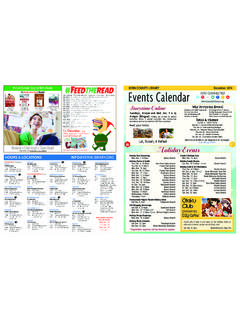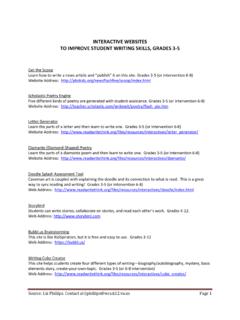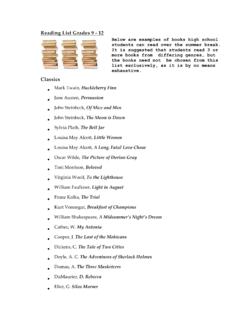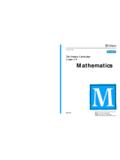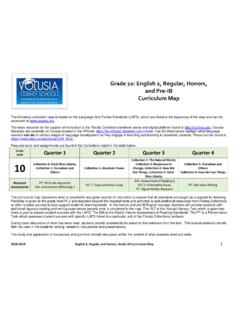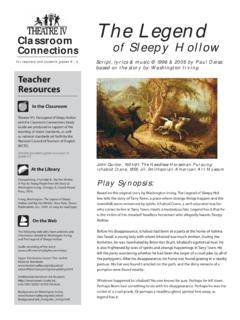Transcription of LAMDA – OWN CHOICE OF PROSE (APPROPRIATE FOR …
1 LAMDA OWN CHOICE OF PROSE (APPROPRIATE FOR GRADES 2-5 VP & ALL RP GRADES) Out of the Ashes, The Nine Lives of Montezuma, The Last Wolf, The Butterfly Lion, Private Peaceful, Born to Run by Michael Murpurgo Ballet Shoes by Noel Streatfield By Royal Command by Charlie Higson Septimus Heap by Angie Sage New Moon, Twilight by Stephanie Meyer Five on a Treasure Island by Enid Blyton Just so Stories by Rudyard Kipling The Ghost of Thomas Kempe by Penelope Lively The Boy in the Striped Pyjamas by John Boyne I am David by Ann Holm Sherlock Holmes by Conan Doyle The White Giraffe by Lauren St John Dragon s Breath by Baker Charlie Bone by Jenny Nimmo My Family & Other animals by Gerald Durrell Inkheart by Cornelia Funke Jimmy Coates by Joe Craig The Shade of Hettie Daynes by Robert Swindells Harry Potter & the Deathly Hallows/Order of the Phoenix by JK Rowling Jane Eyre by Charlotte Bronte Swallows &
2 Amazons by Arthur Ransome The Wind in the Willows by Kenneth Greene The Storm Catchers by Tim Bowler Deadly Dares/Noughts & Crosses by Malorie Blackman Elsewhere by Gabrielle Zevin Charlie & the Choc Factory, Fantastic Mr Fox, The Magic Finger, Boy, Going Solo by Roald Dahl How to be a Pirate by Cressida Cowell Nightmare Hour by R. L. Stine Eldest by Christopher Paolini Skulduggery Pleasant by Derek Landy The Colossus of Rhodes by Caroline Lawrence Hitler s Canary by Sandi Toksvig The Wide Window/ The End by Lemony Snickett The Secret Countess by Eva Ibbotson Vanilla Fudge by Deborah Van Der Beek Clarice Bean, Don t Look Now by Lauren Child Warrior Cats by Erin Hunter The Worry Website, The Mum Minder, Tracey Beaker, Diamond Girls, Cookie by Jacquline Wilson The Lion.
3 The Witch & the Wardrobe by Lewis The Diamond of Drury Lane by Linda Golding Flambards by Peyton Doctor Who The Stone Rose by Jacquline Rayner Ibiza Diaries by Grace Dent The Mystery at the Medieval Castle by Lucinda Landon LAMDA VERSE & PROSE THEORY GUIDANCE NOTES 1) LAMDA can ask theory from any previous grades (even if candidate has not taken that grade ) 2) Students can chose their PROSE piece (G2 onwards) from the LAMDA anthology but you must be ABSOLUTELY SURE that they have read the WHOLE book (not just seen the movie!) 3) These notes are for the benefit of students & can be photocopied for their use, they are a pr cis of notes that tutors need to follow from Knowledge Matters.
4 4) Remember to practice sight reading with G4 onwards 5) All exams are 10 minutes, apart from G4 & G5 which are 15 minutes. LAMDA INTRODUCTORY (5 YRS) One LAMDA poem A favourite TOY OR OBJECT is brought along & discussed with the examiner LAMDA PREPARATORY (6 YRS) One LAMDA poem A favourite PICTURE OR PHOTOGRAPH is brought along & discussed with the examiner LAMDA PRELIMINARY (7 YRS) One LAMDA poem A favourite BOOK is brought along & discussed with the examiner LAMDA ENTRY (8 YRS) THEORY (one LAMDA poem/one own CHOICE poem) NB There will be four questions from the examiner in the knowledge section.
5 I) The meaning of the poems (Do they paint a picture? Tell a story? What are the poems trying to say?) ii) The meaning of individual words in both poems LAMDA grade 1 (9 YRS) THEORY (one LAMDA poem/one own CHOICE poem) QUESTIONS WILL BE BASED ON THE FOLLOWING iii) The mood, content & contrast between poems (Are they shaped differently on the page? Do they have strong rhythm? Do they use rhyme? Is the mood different in the poems?) iv) The reasons behind your choices v) The meaning of individual words in both poems LAMDA grade 2 (10 YRS) THEORY (one LAMDA poem/one own CHOICE PROSE ) FIRST TIME RECITING PROSE YOU WILL BE ASKED THE FOLLOWING ABOUT YOUR BOOK 1 What happens in the story?
6 (A succient outline) 2 Where & when is the story set? 3 What is your favourite part of the story? 4 How does the extract you are performing fit into the story as a whole? LAMDA grade 3 (11 YRS) THEORY (one LAMDA poem/one own CHOICE PROSE ) Questions will be based on two characters from the story: 1) Why have you chosen them? 2) Are they the main characters? 3) What do you think they look like? 4) What do they say about themselves? 5) What happens to them & why? 6) Do they know each other? *You will be asked about two specific characters from your PROSE CHOICE THE DIFFERENCES BETWEEN VERSE & PROSE i) LAYOUT: In English, both flow from left to right of page.
7 In verse words are shaped & arranged into patterns & sometimes stanzas. ii) RHYTHM: Both posses rhythm which is a beat or pulse you can hear when you say words. When rhythm has a regular pattern of syllables this is called metre. In verse rhythm is more distinct and may be strong or subtle. iii) LANGUAGE: PROSE has logical sequence & grammatical order. Verse may change word order or omit words/punctuation. Verse may also make more use of similes & metaphors. LAMDA grade 4 (12 YRS) THEORY (one LAMDA poem/one own CHOICE PROSE /sight reading) SIGHT READING i.
8 Scroll thumb down side of page ii. Good eye contact without losing place iii. Appropriate expression, diction, clarity, pace, volume & stress THE RELATIONSHIP BETWEEN TWO CHARACTERS 1) What do they say about each other? 2) What do other people say about them? 3) How do they relate to each other? 4) How does their relationship develop/change & why? FIGURES OF SPEECH ALLITERATION Repetition of an initial consonant eg Firelight, lamplight, the little lame cat ASSONANCE Repetition of a vowel sound eg a flicker of light, glittering, just out of sight ONOMATOPOEIA Words that make a similar sound to their meaning when spoken aloud eg pop/hiss ANTITHESIS When a word,phrase or idea is set in opposition to another, resulting in a strong contrast or ambiguity which can often surprise or shock eg Dinosaur roar, dinosaur squeak, Dinosaur fierce, dinosaur meek.
9 PUN When a word with 2 different meanings, both relevant to the context, is used eg Thank goodness , the carp thought, That rivers have banks! SIMILIE When one thing is likened to another, recognised by use of like or as eg My love is like a red, red rose METAPHOR Turns on thing into something else eg Beware, my lord, of jealousy; it is the green-eyed monster, which doth mock, the meat it feeds onLAMDA grade 5 (13 YRS) THEORY (one LAMDA poem/one own CHOICE PROSE /sight reading) THE PLOT OF THE BOOK (A narrative of events with emphasis on cause & effect) Be able to discuss what happened the books development & outcome PHRASING (A group of words which make sense, but not complete sense on their own) i) SENSE-GROUPS: A group of words which make sense when put together, often introducing a fresh idea.
10 Ii) BREATH-GROUPS: The number of sense-groups that can be easily said in one breath. May be longer than sense-groups and should occur where a longer pause is indicated by text. iii) PARENTHESIS: Brackets, commas, hyphens used when a word, phrase or sentence is inserted as an explanation or after thought. The PROSE would make sense if the words inside parenthesis were removed. PAUSING (When sound stops brings meaning & mood) i) SENSE PAUSE: Oral punctuation used to mark the sense at the beginning or end of a sense-group. ii) EMPHATIC PAUSE: A pause used to isolate a word or phrase which therefore achieves prominence & builds suspense and climax.
